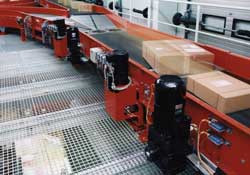
Posted to News on 12th Nov 2008, 16:20
How to cut the life cycle cost of automation projects
Lenze explains how automation incorporating with motors, brakes, gearboxes and inverter drives can be designed so as to reduce the life cycle cost (LCC) and total cost of ownership (TCO).

Machine builders today have to cater for lower cycle times, higher operating times and perhaps fully automatic 24-hour operation. Ambient conditions and increased powers demand more effective cooling. Machine designers have to balance the warranty offered by the drive supplier, which may be two years excluding wearing parts, against increasing customer demands for reduced Life Cycle Costs (LCC) and Total Cost of Ownership (TCO). How can drive products such as motors, brakes, gearboxes and frequency inverters achieve longer life under conditions of increased usage? Lenze says it has applied design and sizing expertise to these products and achieved this target.
Electric motors are being subjected to a trend of increasing operating speeds under inverter control. What was a running speed based on 50Hz frequency can now be 70Hz, or even 87Hz with the corresponding increase in power and heating. One of the weak points is the shaft seal between the motor and the gearbox. Through a joint project with seal manufacturers, Lenze has optimised this seal to achieve lower surface pressure and a life increase that can be from 3000 to 9000 hours.
Motor costs can be reduced in other ways. With servo motors Lenze can supply preassembled plugs and cables for the power, feedback and blower connections. This speeds build times and any subsequent maintenance operations, and there is no need for a qualified electrician. For standard motors used in frequency inverter operation, it is possible to choose single- or multi-turn encoders as a standard option. This also keeps costs down.
Brakes guaranteed for 10million operations
Spring-applied motor brakes for holding and emergency stops can be a weak link when cycle rates increase. Lenze has offered low-wear friction material since 2004, but wear on other mechanical parts as the brake opens and closes can restrict life to about one million operations. However, a new long-life design is now available wherein the sliding splines are coated in a special polymeric material that reduces wear. In addition, guide pins and spring tappets eliminate the highly stressed areas that result from the cyclic armature plate movement. The result is a large increase in life, with 10million operations guaranteed and an expected life two times higher than that. The latest Lenze inverters even have protected relays to switch the brake built in as a standard, which avoids the need for external components.
Gearboxes are today expected to operate reliably with higher motor input speeds. This results in increased heating within the gearbox and an increase in internal pressure, which, in turn, depends on the oil fill and the mounting position. These factors can result in oil loss through seals and ultimately a reduction in service life. To combat this, Lenze has introduced gearbox ventilation as standard on all models in its G-motion range from 06. The vent valves open if the pressure exceeds 0.2bar, which reduces oil foaming and oxidation. The life of the gearbox seals is extended by between 25 and 100 per cent.
With energy costs as a driving factor, plant operators will increasingly scrutinise Life Cycle Costs and Total Cost of Ownership for new machines. Lenze can assist with the LCC calculation using standard forecasting models such as are being developed by the German VDMA trade organisation. Often the largest factor is the energy usage pointing towards the use of inverters to control speed to match demand, energy-efficient motors and efficient gearing. In one recent case, a five-year forecast for drives at an end user plant was able to show that the optimum size selection is a function of the usage. For single-shift operation the LCC for a Lenze GST04 gearbox was marginally less than the next size up GST05. However, on three-shift operation the GST05 repaid the higher purchase cost with a LCC that was 13 per cent lower. This is a consequence of the longer service life of the bigger gearbox.
What is the right size for a drive?
Correct sizing of a drive to the application conditions is critical for energy saving and TCO. An undersized drive will fail and incur maintenance costs. On the other hand, an oversized drive, particularly if run below its optimum speed or at partial load, will exhibit low efficiency and therefore waste energy. Lenze has adopted the concept of Rightsizing, which is sizing a drive from a broad range with models that are finely stepped, and using strong expertise from trained engineers or specialist software tools.
The difference between price and cost can be vast - where price is defined as the purchase price off the machine and cost is the Total Cost of Ownership. Plant operators need to look right through the life cycle up to disposal costs. Lenze products offer good opportunities for recycling; for example, the steel and iron content in gearboxes, and RoHS certification on the drives. Elsewhere new developments from Lenze are making big increases in service life to meet the higher machine operating conditions. These improvements are available either as standard at no extra cost, or for only a small premium.
Follow the link to access engineering tools from Lenze.
Want the latest machine building news straight to your inbox? Become a MachineBuilding member for free today >>















